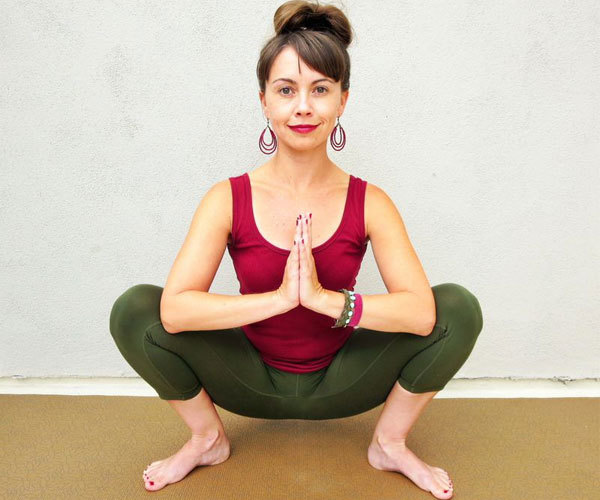Tight hips can be debilitating. When things aren’t working right down there, even sitting or walking can cause pain. Luckily, a little (proper) stretching can ward off this pain, increase the fluidity of mobility, and decrease chances of serious injury in the lower region of your body. It can also take pressure off the lower back, decreasing chances of pain in that area.
These 8 simple poses can help both stretch and strengthen your hips, but keep in mind when moving through them to listen to that internal voice of your body that tells you if you are in pain or just feeling a stretch. A stretch may feel a little sore but inevitably it feels like a release of tension. When you feel sharp pain, back out of the pose and consider using a prop or moving on to another stretch.
Lizard-Lower Lunge
Apparently, lizards have loose hips and this hip opener’s moniker is testament to that. Step your left foot forward several feet in front of the right foot. Bend the left knee until it lines up perfectly with the ankle. Drop the right knee to the ground and keep the toes curled under on that foot to stretch the calf muscle. Walk the left foot out to the side and place both elbows on top of blocks on the inside edge of the left foot. Keep hips lined up parallel to each other. You are opening the right psoas muscle and the left inner thigh. To get deeper into the right psoas, lift the right knee into a high lunge.
Apparently, lizards have loose hips and this hip opener’s moniker is testament to that. Step your left foot forward several feet in front of the right foot. Bend the left knee until it lines up perfectly with the ankle. Drop the right knee to the ground and keep the toes curled under on that foot to stretch the calf muscle. Walk the left foot out to the side and place both elbows on top of blocks on the inside edge of the left foot. Keep hips lined up parallel to each other. You are opening the right psoas muscle and the left inner thigh. To get deeper into the right psoas, lift the right knee into a high lunge.
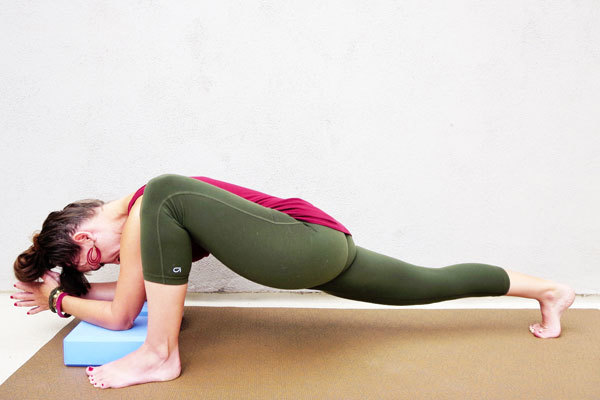
Bound Ankle Pose
This pose requires that you bind your ankles—and by doing so you’ll unbind your hips. Bring the soles of your feet together, pulling the heels close to your groin, bending the knees, and butterfly flare the legs open. If you notice your knees are set too high to relax, simply place a blanket right under the sit bones to prop the hips up. You can also take the feet out further from the pelvic cavity to create a diamond shape with the legs. Keeping your spine straight, lead with the chest, pull your shoulders back, and fold toward your feet. This pose will open and relax the inner thighs and groin.
This pose requires that you bind your ankles—and by doing so you’ll unbind your hips. Bring the soles of your feet together, pulling the heels close to your groin, bending the knees, and butterfly flare the legs open. If you notice your knees are set too high to relax, simply place a blanket right under the sit bones to prop the hips up. You can also take the feet out further from the pelvic cavity to create a diamond shape with the legs. Keeping your spine straight, lead with the chest, pull your shoulders back, and fold toward your feet. This pose will open and relax the inner thighs and groin.
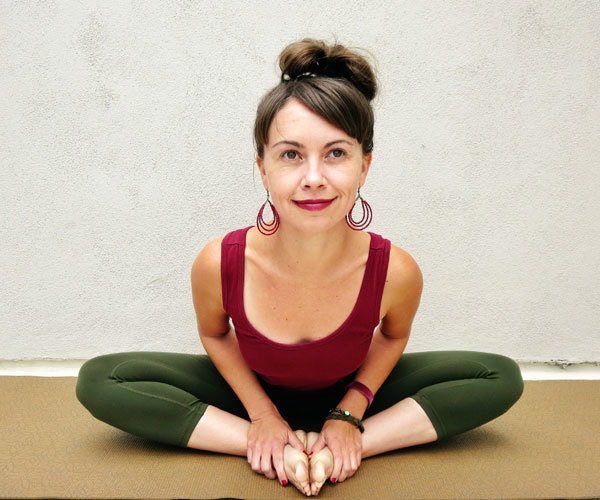
Cow Face Pose
Begin by threading the left leg under your right leg. Work toward stacking the knees, while keeping both sit bones on the ground. Tuck the toes in to protect the knees. Sit in the pose for several minutes. When the muscles start to loosen and you no longer feel a stretch, fold forward with a straight spine. If this stretch is too intense, you can situate both sit bones on a blanket and place a block or blanket between the knees.
Begin by threading the left leg under your right leg. Work toward stacking the knees, while keeping both sit bones on the ground. Tuck the toes in to protect the knees. Sit in the pose for several minutes. When the muscles start to loosen and you no longer feel a stretch, fold forward with a straight spine. If this stretch is too intense, you can situate both sit bones on a blanket and place a block or blanket between the knees.
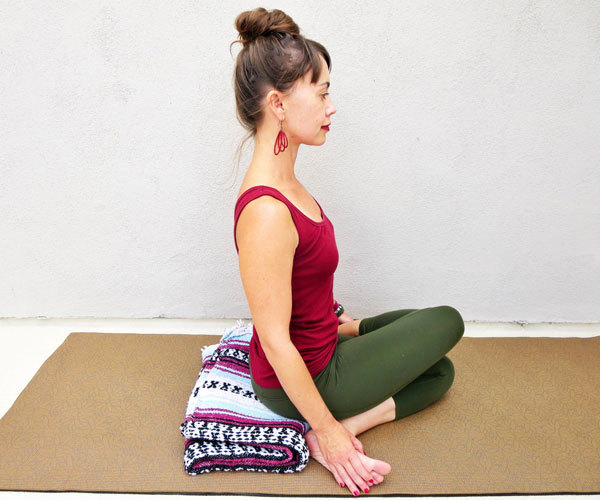
Pigeon Pose
Starting in downward facing dog, lift the right leg and step it forward between the hands. Drop the left knee down and untuck the toes. Slide the right foot over toward your left pelvic bone placing the outside edge of the right leg on the floor. Tuck the right toes in (flexing the foot). Line up hips parallel to each other, continually pressing the left hip toward the floor. If this position is too difficult, place a blanket under your bottom. To intensify the stretch, move the right foot away from the left side of your body and drop to the elbows or chest. To make this pose less intense, move the right foot closer to your right leg and stay on the hands instead of folding. This is a profound stretch to the psoas, shin, glutes, and outer hips.
Starting in downward facing dog, lift the right leg and step it forward between the hands. Drop the left knee down and untuck the toes. Slide the right foot over toward your left pelvic bone placing the outside edge of the right leg on the floor. Tuck the right toes in (flexing the foot). Line up hips parallel to each other, continually pressing the left hip toward the floor. If this position is too difficult, place a blanket under your bottom. To intensify the stretch, move the right foot away from the left side of your body and drop to the elbows or chest. To make this pose less intense, move the right foot closer to your right leg and stay on the hands instead of folding. This is a profound stretch to the psoas, shin, glutes, and outer hips.

Happy Baby
It’s not likely you will ever hear a baby complaining about hip pain. So, make like a baby and lie flat on your back, grab hold of both feet with each hand, bend the knees and pull them toward your armpits. Once in the proper position rock side to side, keeping your head on the floor. This will externally rotate and stretch the hips, loosen the inner groin muscles, and help realign the spine.
It’s not likely you will ever hear a baby complaining about hip pain. So, make like a baby and lie flat on your back, grab hold of both feet with each hand, bend the knees and pull them toward your armpits. Once in the proper position rock side to side, keeping your head on the floor. This will externally rotate and stretch the hips, loosen the inner groin muscles, and help realign the spine.
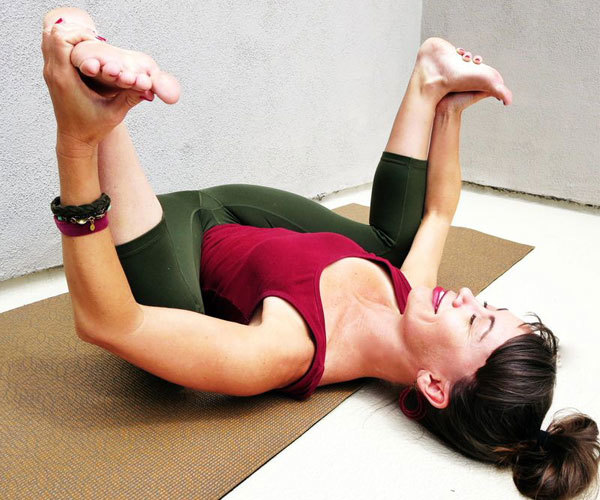
Fire Log Pose
This pose should put the fire out in your hips. Sit on the floor with a straight spine, both sit bones pressing against the ground. Take the left leg out in front of you and bend it until it is in a straight line and parallel with your body, knee, and ankle. Stack the right leg on top of the left, lining up the right ankle to the left knee and the right knee to the left ankle. If you find the final position too difficult, you can use blocks as support to lighten the pose. This is a deep stretch to loosen the outer hips and glutes. It also stretches and strengthens the groin, calves, thighs, and abdominal muscles.
This pose should put the fire out in your hips. Sit on the floor with a straight spine, both sit bones pressing against the ground. Take the left leg out in front of you and bend it until it is in a straight line and parallel with your body, knee, and ankle. Stack the right leg on top of the left, lining up the right ankle to the left knee and the right knee to the left ankle. If you find the final position too difficult, you can use blocks as support to lighten the pose. This is a deep stretch to loosen the outer hips and glutes. It also stretches and strengthens the groin, calves, thighs, and abdominal muscles.
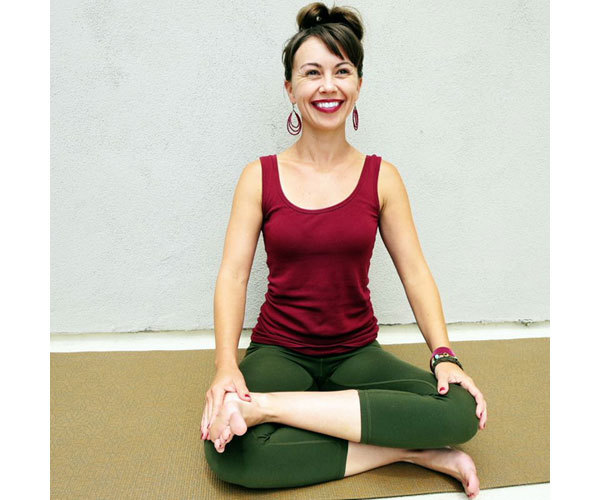
Goddess Pose
Gentlemen, do not be deterred by the name of this pose. It will help you open your hips regardless of your gender. Step your feet out very wide, turn the toes outward, bend the knees so they line up with your ankles, and tuck your butt in to engage the core. The further the toes are pointed outward, the deeper the stretch. This will give your groin, inner thighs, and hips a deep stretch. Note: Avoid this pose if you have a knee or hip injury.
Gentlemen, do not be deterred by the name of this pose. It will help you open your hips regardless of your gender. Step your feet out very wide, turn the toes outward, bend the knees so they line up with your ankles, and tuck your butt in to engage the core. The further the toes are pointed outward, the deeper the stretch. This will give your groin, inner thighs, and hips a deep stretch. Note: Avoid this pose if you have a knee or hip injury.
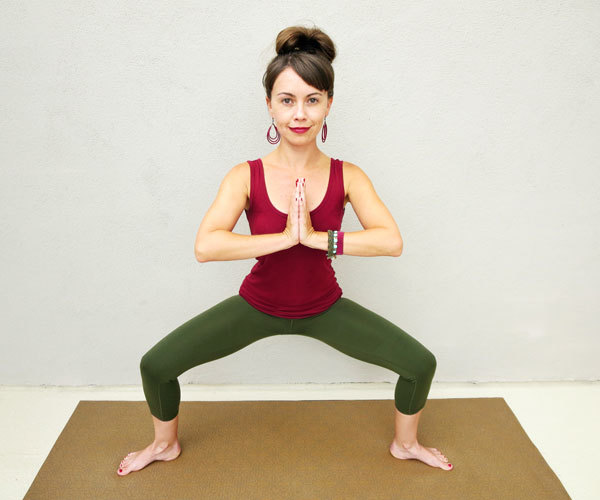
Half Lord of The Fish Pose
Sitting on the floor, extend both legs out in front of you. Keep the left leg straight and bend and pull the right leg in. Line the right heel up approximately 2 inches away from the back of the right leg and 2 inches away from the left thigh. Sit up very tall, avoiding sinking in the lower back. Wrap the left arm around the right leg, creating a spinal twist. Move the left shoulder forward as you move the right shoulder back, attempting to line the shoulders up. Take your gaze over the right shoulder. This pose stretches out the hips, glutes, lower back, spine, chest, shoulders, and neck.
Sitting on the floor, extend both legs out in front of you. Keep the left leg straight and bend and pull the right leg in. Line the right heel up approximately 2 inches away from the back of the right leg and 2 inches away from the left thigh. Sit up very tall, avoiding sinking in the lower back. Wrap the left arm around the right leg, creating a spinal twist. Move the left shoulder forward as you move the right shoulder back, attempting to line the shoulders up. Take your gaze over the right shoulder. This pose stretches out the hips, glutes, lower back, spine, chest, shoulders, and neck.
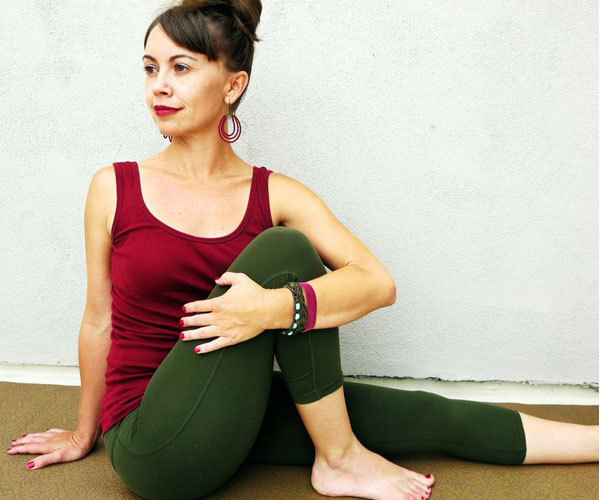
Garland Pose
This pose is so effective for opening the hips that it’s the position most women use to give birth. Turn your heels so they line up with your hips, turn your toes outward. Bend the knees until you reach a squatted position. Place a blanket under the heels if they have to be lifted while squatting. You can also stack two blocks to sit on to work up to the full integrity of the pose. The Garland Pose increases fluidity in the hips, and stretches the ankles, knees, and lower back. It also strengthens the core muscles.
This pose is so effective for opening the hips that it’s the position most women use to give birth. Turn your heels so they line up with your hips, turn your toes outward. Bend the knees until you reach a squatted position. Place a blanket under the heels if they have to be lifted while squatting. You can also stack two blocks to sit on to work up to the full integrity of the pose. The Garland Pose increases fluidity in the hips, and stretches the ankles, knees, and lower back. It also strengthens the core muscles.
